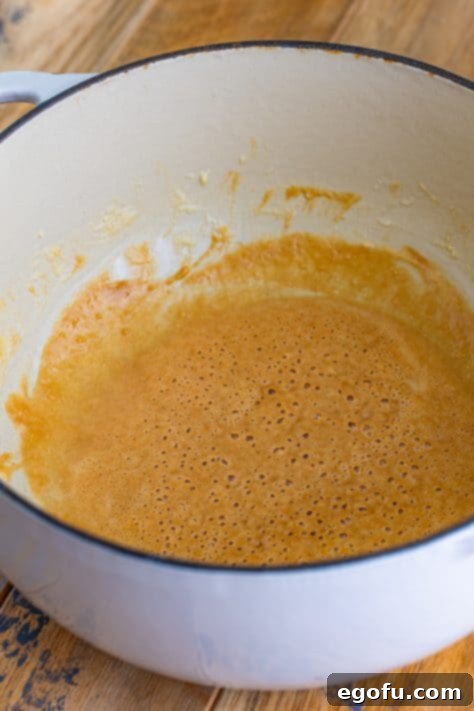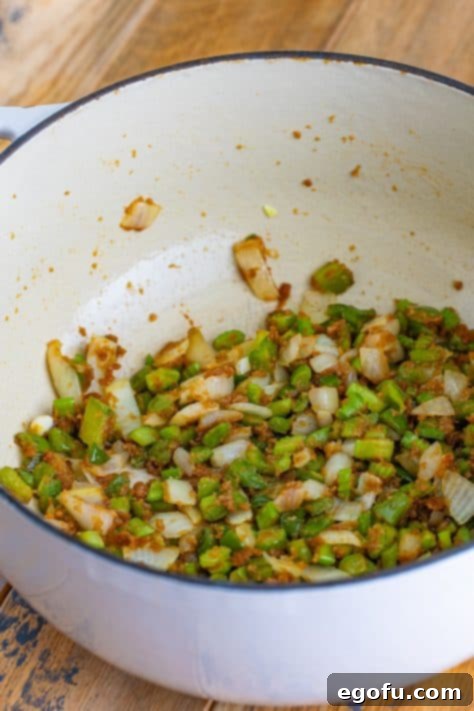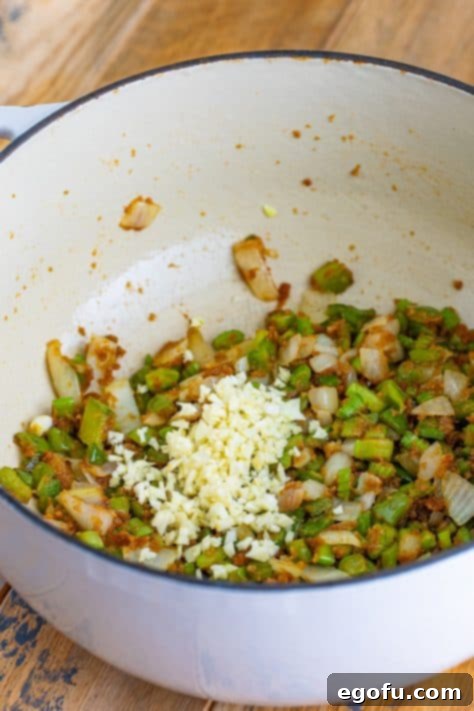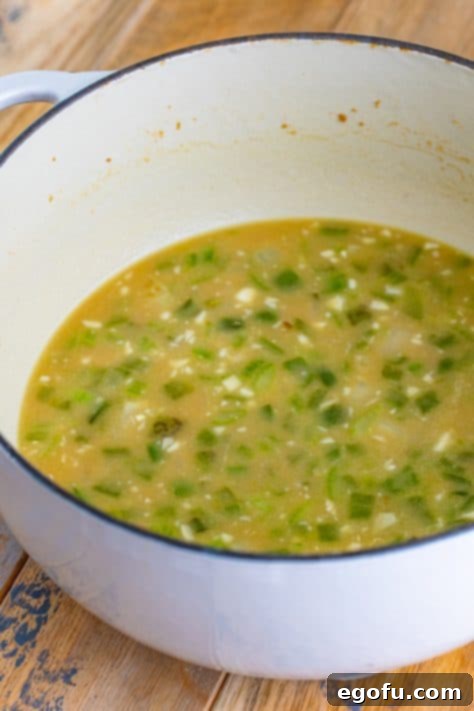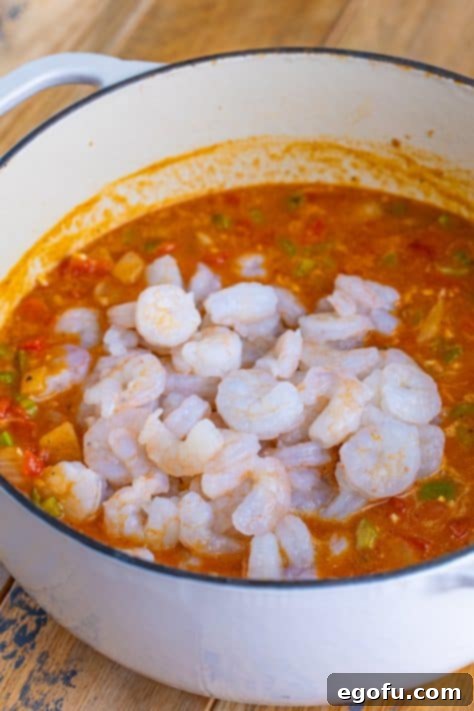Shrimp Étouffée is a magnificent meal that often appears complex, yet is surprisingly accessible for home cooks. This beloved Southern classic, rich with deep, savory flavors, can be prepared in under an hour, making it perfect for both weeknight dinners and special occasions.
Authentic Louisiana Shrimp Étouffée: A Flavorful Southern Classic
Embark on a culinary journey to the heart of Louisiana with our irresistible Shrimp Étouffée recipe. This iconic seafood dish is a testament to the vibrant and soulful flavors of Southern cuisine, featuring succulent shrimp, aromatic vegetables, and a perfectly balanced blend of spices. At the core of any great étouffée, much like its cousin gumbo, lies the roux – a golden foundation that infuses the entire dish with its signature depth and richness. What makes this recipe truly special is its incredible depth of flavor combined with a straightforward preparation process, allowing you to bring a taste of the Bayou right into your kitchen. It’s a comforting, homemade meal that’s not only a crowd-pleaser but also wonderfully versatile, easily adaptable to your family’s preferences.
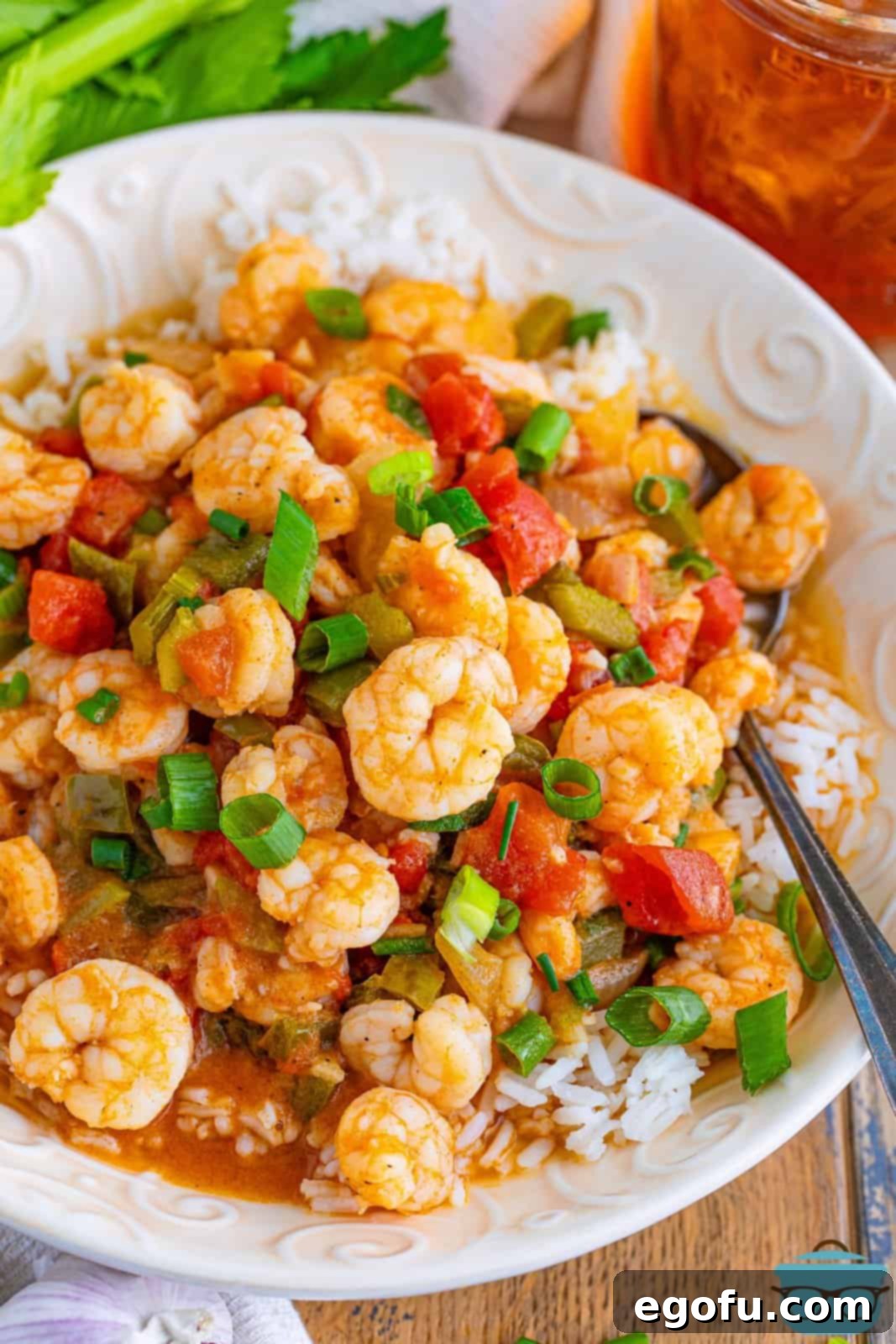
Frequently Asked Questions About Shrimp Étouffée
Shrimp Étouffée is a classic Louisiana dish, deeply rooted in Cajun and Creole culinary traditions. The word “étouffée” comes from the French word “étouffer,” meaning “to smother,” referring to the cooking method where ingredients are smothered in a rich, flavorful sauce. While often compared to gumbo, étouffée typically features a thicker, smoother gravy-like consistency and centers around one main protein, usually shrimp or crawfish. Unlike gumbo, which often includes a wider variety of meats and a thinner, soup-like broth, étouffée focuses on the “smothered” shellfish and a simpler vegetable base, known as the “Holy Trinity.” The ingredients for this particular Shrimp Étouffée recipe are readily available, making it a convenient and authentic Southern meal you can easily prepare at home, even if you’re new to Cajun cooking.
Absolutely! Étouffée is incredibly versatile, and you can certainly customize the protein to your liking. While shrimp is traditional, chicken is a fantastic alternative that many find equally delicious. If you’re looking for a different but equally satisfying experience, we even have a dedicated recipe for Chicken Étouffée. You could also try it with succulent crawfish tails for a truly authentic Louisiana feel, or incorporate savory sausage for an extra layer of flavor and heartiness. Just ensure whatever protein you choose is cooked through to perfection and complements the rich sauce.
The choice of shrimp size largely depends on personal preference and availability in your local market. We typically recommend using medium-sized shrimp because they are often more affordable and provide a pleasant, bite-sized experience within the rich sauce. They cook evenly and remain tender without being overwhelming. However, feel free to use larger shrimp if you prefer a more substantial piece in your dish. Regardless of the size you choose, the most important step is to ensure your shrimp are fully peeled and deveined before cooking. This guarantees a clean taste and optimal texture in your finished étouffée.
Shrimp Étouffée is traditionally and most commonly served over a bed of fluffy white rice. The rice perfectly soaks up the rich and savory sauce, creating a harmonious and comforting meal. However, its versatility allows for many other delicious pairings. You can enjoy it on its own as a hearty stew, or with other accompaniments that are excellent for absorbing that incredible gravy. Consider serving it with creamy mashed potatoes, crusty French bread or warm cornbread for dipping, creamy polenta, or even classic Southern-style grits. For a slightly healthier or different twist, quinoa can also work surprisingly well. A simple green salad makes a refreshing contrast.
While some recipes might suggest searing shrimp beforehand to develop more flavor or achieve a specific texture, it’s generally not necessary for Étouffée and can actually increase the risk of overcooking the delicate seafood. Shrimp cooks quite quickly, and adding it directly to the simmering, flavorful sauce allows it to gently poach and absorb all the incredible spices and liquid without becoming rubbery or tough. We highly recommend adding the raw, peeled, and deveined shrimp directly to the sauce near the end of the cooking process to ensure it remains tender, juicy, and perfectly cooked, contributing its natural sweetness to the dish.
Yes, you can certainly use pre-cooked shrimp, though raw shrimp typically yields a slightly more tender and juicy result and infuses more flavor into the sauce as it cooks. If opting for pre-cooked shrimp, the key is to add it at the very end of the cooking process. Stir it into the hot étouffée just long enough to heat it through, usually for only 1-2 minutes, preventing it from overcooking. Overcooked shrimp can become tough and chewy, so mindful timing is crucial here. While raw shrimp will contribute more depth to the sauce, using pre-cooked shrimp can still result in a delicious and satisfying Étouffée, especially when you’re short on time.
Proper storage is key to enjoying your Étouffée leftovers safely and deliciously. Once the étouffée has cooled completely, transfer any remaining portions to an airtight container. It can then be stored in the refrigerator for up to 3 days. For longer-term storage, Shrimp Étouffée freezes beautifully. Simply place it in a freezer-safe container or a heavy-duty freezer bag, making sure to remove as much air as possible to prevent freezer burn, and freeze for up to 3 months. When ready to enjoy, thaw it overnight in the refrigerator before proceeding with reheating.
To reheat, we recommend gently warming your Étouffée on the stovetop over medium-low heat. Stir occasionally until it’s heated through evenly. It’s perfectly normal for étouffée to thicken considerably as it cools and sits in the refrigerator, due to the starch in the roux. If your leftovers are too thick for your preference, you can easily thin them out to your desired consistency by adding a splash of chicken stock, water, or even a touch of cream while reheating. This will help restore its creamy, luscious texture and ensure it’s just as delicious as when it was first made.

Mastering the Roux: The Soul of Your Étouffée
The foundation of any exceptional Cajun or Creole dish, including this Shrimp Étouffée, is a perfectly made roux. A roux is a simple yet crucial mixture of equal parts fat (in this case, butter) and flour, cooked together to create both a thickening agent and a deep, nutty flavor base. For étouffée, we aim for a rich “peanut butter” colored roux, which provides a profound depth of flavor without being as dark and intense as the chocolate-colored roux often used in gumbo. This specific color signifies that the flour has cooked long enough to eliminate any raw taste and has begun to caramelize, contributing significantly to the dish’s complexity and signature character. Patience is paramount when making a roux; whisk it constantly over medium heat to prevent burning and ensure even browning. A well-executed roux is the undeniable secret to achieving an authentic, restaurant-quality étouffée right in your own kitchen.
Essential Ingredients for the Best Shrimp Étouffée
Gathering the right ingredients and understanding their roles is the first step to creating a truly memorable Shrimp Étouffée. Each component plays a vital role in building the layered and harmonious flavors of this beloved Southern dish. (For exact measurements and serving sizes, please refer to the complete recipe card below.)
- Salted Butter: While other fats like oil or shortening can be used, good quality salted butter is highly recommended for its unmatched contribution to the richness and flavor profile of the roux and the overall dish. It lends a creamy, luxurious mouthfeel that enhances the étouffée’s comforting character.
- All-Purpose Flour: This is the crucial component for creating the roux, which acts as both a thickener and a flavor base. A roux is simply butter and flour cooked together. Cooking the flour helps eliminate its raw taste and, as it browns, develops those deep, nutty notes essential to étouffée. It’s the secret to achieving a smooth, lump-free, and wonderfully flavorful sauce.
- Celery, Green Bell Pepper, and Onion: Known affectionately as the “Holy Trinity” in Cajun and Creole cooking, these three aromatic vegetables form the indispensable flavor foundation of the étouffée. Finely diced, they are sautéed until tender, releasing their sweet, savory, and earthy flavors into the sauce. While fresh is always best, pre-chopped frozen varieties can be a convenient shortcut for busy weeknights. Don’t hesitate to adjust quantities based on your personal preference.
- Fresh Garlic: The importance of freshly minced garlic cannot be overstated in authentic Southern cooking. Its pungent, vibrant, and aromatic qualities are far superior to the milder, sometimes metallic taste of jarred garlic, which often contains preservatives. Take the extra minute to mince fresh garlic; it makes a world of difference to the étouffée’s overall taste and aroma.
- Chicken Stock: Opting for quality chicken stock over plain broth will provide a significantly richer, more profound depth of flavor to your étouffée. Stock is typically made from simmering bones and vegetables, yielding a more robust and gelatinous liquid that enhances the body and taste of the sauce. If you’re managing sodium intake, a low-sodium or no-sodium chicken stock is an excellent choice.
- Petite Diced Tomatoes (Undrained): These tomatoes add a subtle tang, a touch of brightness, and a slight textual element to the étouffée. Be mindful when purchasing to choose plain petite diced tomatoes, as some varieties come with Italian seasonings or other flavorings which would alter the authentic profile of this Southern dish. The undrained liquid contributes essential moisture and depth to the sauce’s body.
- Worcestershire Sauce: This ingredient acts as a powerful yet subtle flavor enhancer, providing a crucial layer of umami and complexity without imparting a dominant taste of its own. It melds seamlessly with the other spices and liquids, deepening the overall savory character of the étouffée.
- Bay Leaf: A single bay leaf slowly infuses the étouffée with a subtle, earthy, and slightly floral aroma as it simmers. Its purpose is purely for flavoring, so remember to remove it before serving to avoid a bitter taste.
- Creole Seasoning: This vibrant spice blend is quintessential to Cajun and Creole cuisine, offering a harmonious mix of savory, spicy, and aromatic notes that define the dish’s character. Brands like Tony Chachere’s are popular and reliable choices, but feel free to use your preferred creole or cajun seasoning, adjusting the quantity to your desired level of spice and heat.
- Smoked Paprika: While regular paprika can be used, smoked paprika introduces an additional layer of rich, smoky flavor that complements the étouffée beautifully. It adds a subtle warmth and complexity, enhancing the overall profile of the dish and giving it a unique depth.
- Kosher Salt and Black Pepper: These are essential for seasoning, balancing, and enhancing all the other wonderful flavors in the dish. Always taste and adjust as you go, especially since creole seasoning already contributes some salt. Freshly ground black pepper is always preferred for its vibrant aroma.
- Medium Shrimp: The succulent star of the dish! Look for raw shrimp, ideally already shelled and deveined for maximum convenience and quicker preparation. If not, make sure to properly peel and devein them before cooking. Medium shrimp integrate perfectly into the sauce, ensuring every spoonful is packed with their sweet, tender flavor.
- Fresh Lemon Juice (Optional): A bright squeeze of fresh lemon juice stirred in at the very end might sound unusual, but it’s a secret weapon for truly brightening the flavors of the entire dish. It cuts through the richness, adding a refreshing zest and making all the other flavors pop. Crucially, avoid bottled lemon juice, as its more concentrated acidity can overpower the delicate balance.
- Hot Sauce (Optional, to taste): For those who love an extra kick of heat and a touch more complexity, a dash or two of your favorite hot sauce can elevate the spice level and add another dimension of flavor. Adjust according to your personal preference for heat.

Creating Your Flavorful Shrimp Étouffée: A Step-by-Step Guide
Making Shrimp Étouffée is a rewarding culinary experience that, while appearing sophisticated, is quite straightforward with the right approach. Following these steps will guide you to a perfectly balanced and deeply flavorful dish, ensuring every spoonful is a taste of Louisiana. Remember, the key is building layers of flavor from the very first step, starting with that essential, golden roux.
Begin by preparing your foundational roux. In a large, heavy-bottomed pot or a sturdy Dutch oven, melt the salted butter over a steady medium heat. Once the butter is fully melted and shimmering, gradually whisk in the all-purpose flour. This initial stage is where the magic truly begins. Continue to cook this mixture, whisking frequently and patiently, until it transforms into a beautiful, rich peanut butter color. This crucial process typically takes about 8 to 10 minutes and is vital for developing the foundational flavor of your étouffée while eliminating any raw flour taste. Do not rush this step, as a perfectly browned roux will contribute immense depth to your finished dish.

Next, introduce the aromatic “Holy Trinity” to your pot. Add the finely diced celery, green bell pepper, and sweet onion directly to the prepared roux, stirring diligently to ensure they are well coated in the flavorful mixture. Continue cooking this combination for another 8 to 10 minutes, stirring occasionally, until these vegetables have softened considerably and become translucent. This step allows them to release their natural sweetness and earthy aromatics, deeply infusing the base of your étouffée with essential Southern flavors.
Once the vegetables are tender, it’s time for the fresh garlic. Stir in the freshly minced garlic and cook for just about 30 seconds, or until it becomes wonderfully fragrant. It’s crucial to be quick here, as garlic can quickly burn and turn bitter. Immediately after the garlic, slowly pour in the rich chicken stock while continuously whisking the contents of the pot. This constant stirring is absolutely vital to prevent any lumps from forming in your sauce, ensuring a perfectly silky-smooth and consistent texture throughout your étouffée.
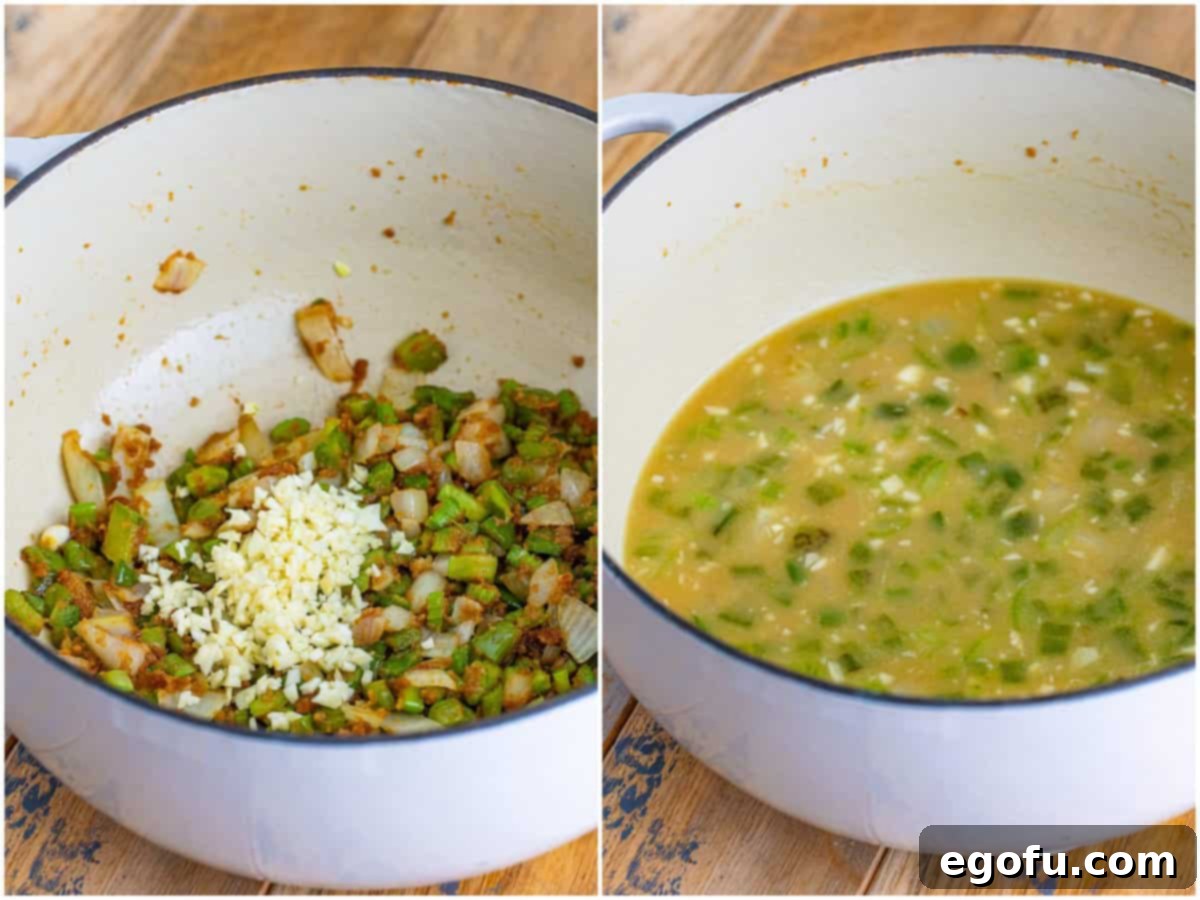
Now, incorporate the remaining foundational ingredients that will bring this étouffée to life: the undrained petite diced tomatoes, a generous dash of Worcestershire sauce, the aromatic bay leaf, a good measure of Creole seasoning, rich smoked paprika, kosher salt, and freshly ground black pepper. Give everything a thorough stir to combine all these fantastic flavors and ensure they are well distributed. Bring the entire mixture to a gentle boil, then immediately reduce the heat to low, stir in your raw medium shrimp, cover the pot, and let it simmer for about 8 to 10 minutes. This simmering time allows the shrimp to cook through gently and the flavors to meld beautifully. Remember to stir occasionally during this period to prevent any sticking to the bottom of your pot and ensure even cooking.
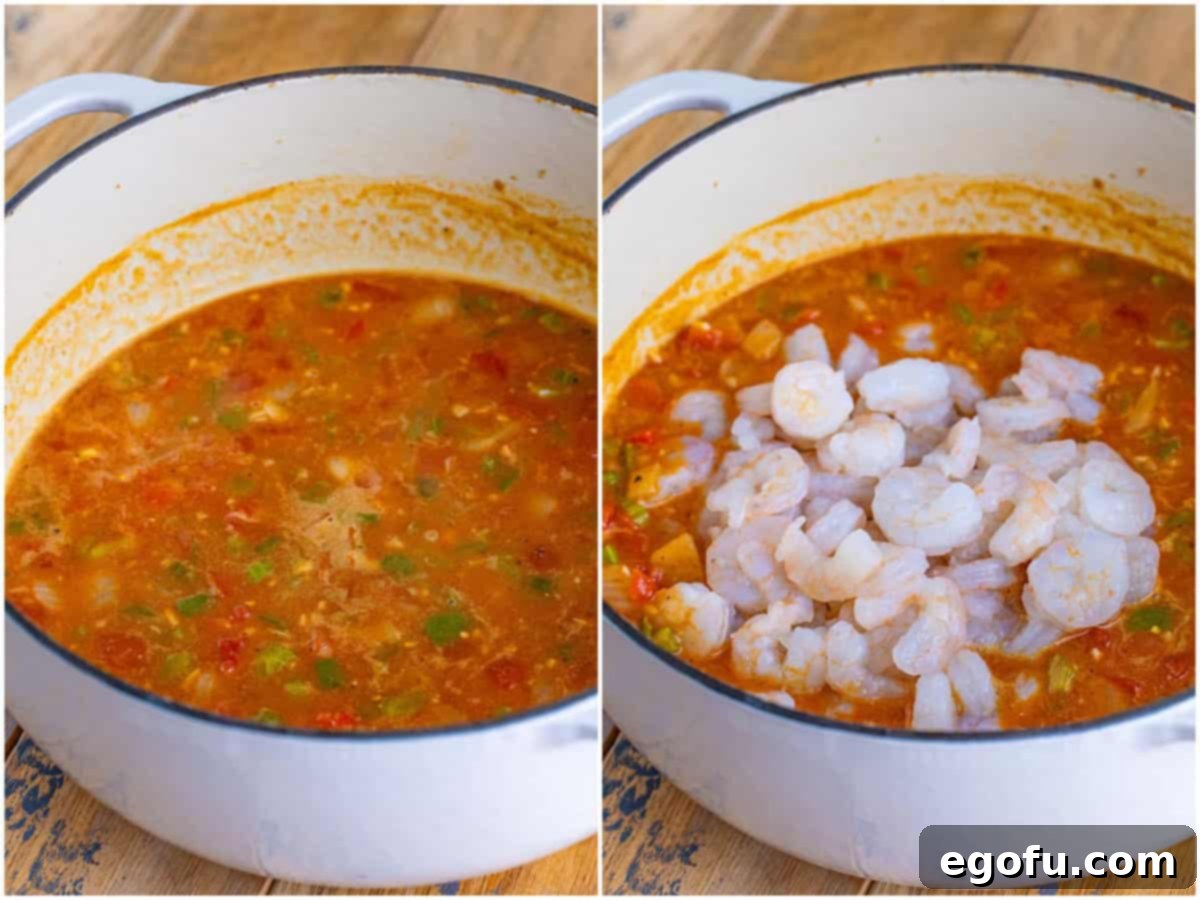
Finally, remove the bay leaf from the pot. Stir in the thinly sliced green onions for a fresh, mild onion flavor, a squeeze of fresh lemon juice (which truly brightens the whole dish and cuts through the richness), and a dash or two of hot sauce to your taste, if you prefer an extra kick. Give it one last gentle stir, then serve your magnificent Shrimp Étouffée immediately over a bed of fluffy rice or your chosen accompaniment. Prepare to savor every spoonful of this incredible Southern comfort food, a testament to the rich culinary traditions of Louisiana.
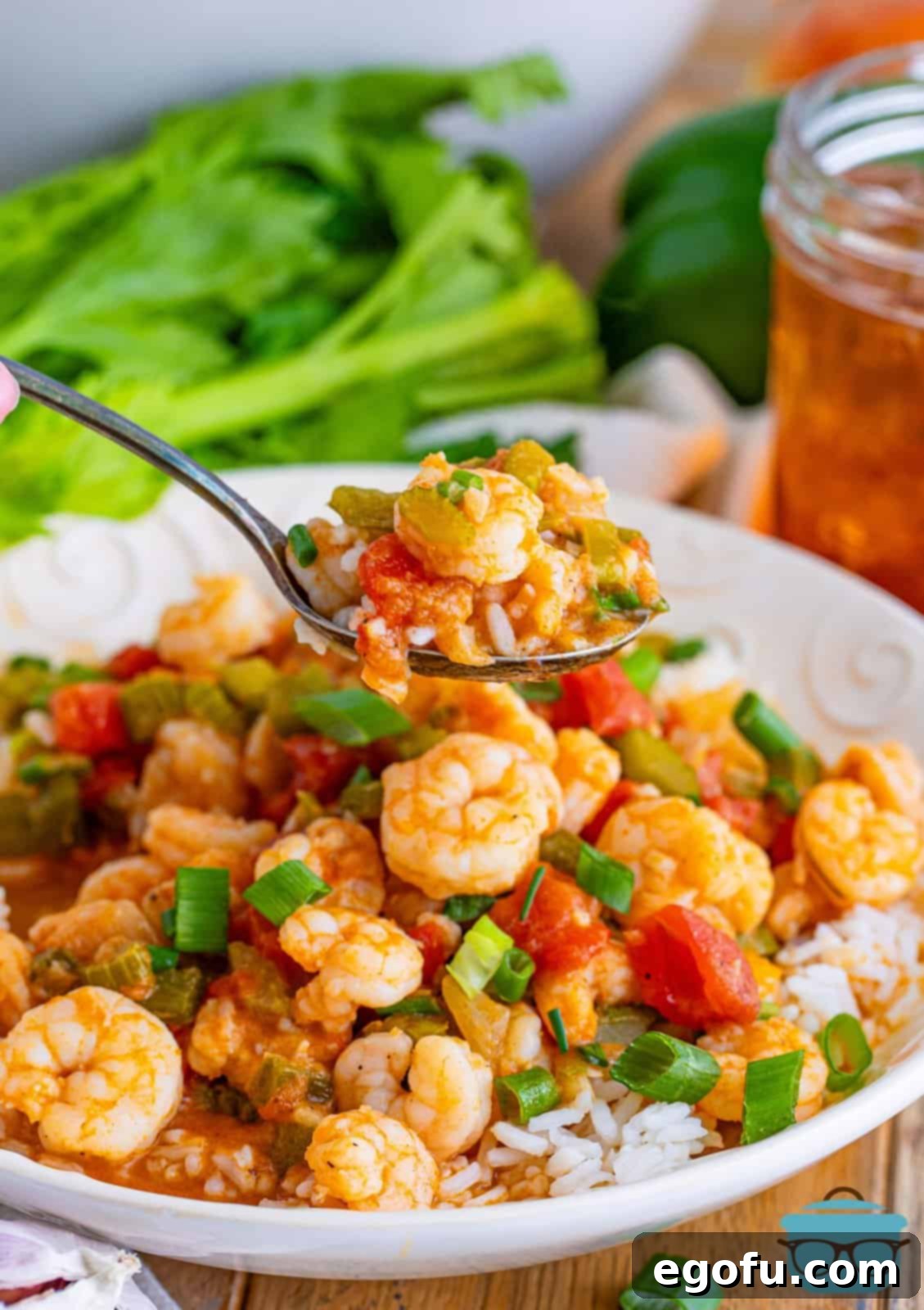
Craving More Southern-Inspired Recipes?
If you’ve enjoyed the rich, soulful flavors of this Shrimp Étouffée, then you’re in for a treat! The culinary traditions of the American South are vast and varied, offering a bounty of comforting and delicious dishes that are perfect for any occasion. Explore more of our favorite Southern-inspired recipes below and bring the warmth, hospitality, and incredible taste of Southern cooking right to your table. From crispy fried delights to hearty stews, there’s always something new and delicious to discover!
- Classic Southern Fried Shrimp
- Easy Slow Cooker Shrimp Boil
- Hearty Southern Shrimp Gumbo
- Authentic Cajun Rice
- Classic Louisiana Jambalaya
- Delicious Shrimp Po’ Boys
- Buttery Creole Shrimp
- Savory Dirty Rice
- Traditional Red Beans and Rice
- Crispy Air Fryer Garlic Butter Shrimp
- Zesty Shrimp Tacos
- Golden Fried Panko Shrimp

Shrimp Étouffée Recipe Card
15
35
50
8 servings
Brandie Skibinski
Ingredients
- ¼ cup (1/2 stick) salted butter
- ¼ cup all-purpose flour
- 2 ribs celery, small diced
- 1 green bell pepper, small diced
- 1 small sweet onion, small diced
- 4 cloves fresh garlic, minced
- 2 cups chicken stock
- 14.5 ounce can petite diced tomatoes (undrained)
- 1 Tablespoon Worcestershire sauce
- 1 bay leaf
- 2 teaspoons creole seasoning
- 2 teaspoons smoked paprika
- ½ teaspoon kosher salt
- ½ teaspoon black pepper
- 2 pounds medium shrimp, shelled and deveined
For Serving:
- 4 green onions, thinly sliced
- ½ fresh lemon, juiced (or to taste)
- hot sauce, to taste
Instructions
- In a large pot or Dutch oven, melt the butter over medium heat.
- Whisk in the flour and continue to cook, whisking often, until it forms a peanut butter color, which typically takes about 10 minutes. This is your roux.

- Add the diced celery, green bell pepper, and onion. Stir them into the roux to combine thoroughly. Cook until the vegetables have softened, about 10 minutes, stirring occasionally.

- Stir in the minced fresh garlic and cook for an additional 30 seconds, or until it becomes fragrant. Be careful not to burn it.

- Slowly stream in the chicken stock while continuously stirring. This ensures a smooth sauce free of lumps.

- Add the undrained petite diced tomatoes, Worcestershire sauce, bay leaf, Creole seasoning, smoked paprika, kosher salt, and black pepper. Stir well to combine all ingredients.

- Bring the mixture to a boil. Once boiling, reduce the heat to low, stir in the raw shrimp, cover the pot, and simmer for 10 minutes. Stir occasionally to prevent sticking and ensure the shrimp cook evenly.

- Remove the bay leaf. Stir in the thinly sliced green onions, fresh lemon juice (if using), and hot sauce to taste. Serve your delicious Shrimp Étouffée immediately, traditionally over rice.

Recipe Notes
- For further details on substitutions, variations, or common questions, please refer to the “Frequently Asked Questions” and detailed ingredient descriptions sections above this recipe card.
- Always taste and adjust seasonings, especially salt and hot sauce, to suit your personal preference before serving. The creole seasoning often contains salt, so factor that in.
- If you prefer a darker roux with a more intense flavor, you can cook it for a few extra minutes until it reaches a chocolate-brown color, similar to what’s often used in traditional gumbo, but be careful not to burn it.
Dinner, Main Dish
American, Cajun, Creole, Southern
Nutrition Information (Estimated per serving)
Calories: 221kcal
|
Carbohydrates: 14g
|
Protein: 26g
|
Fat: 7g
|
Sodium: 527mg
|
Fiber: 2g
|
Sugar: 5g
Nutritional Disclaimer
Please note that “The Country Cook” is not a certified dietician or nutritionist. Any nutritional information provided, such as calorie counts and other values, is an estimate and should be used as a guide only. If precise calorie counts and nutritional values are critical for your dietary needs, we strongly recommend calculating them yourself using your preferred online nutritional calculator. Nutritional values can vary significantly based on the specific brands and quantities of ingredients used in your preparation.
Did you make this delicious recipe?
Share your culinary creations on Instagram and tag us @thecountrycook and use the hashtag #thecountrycook! We love seeing what you cook up in your kitchen!

